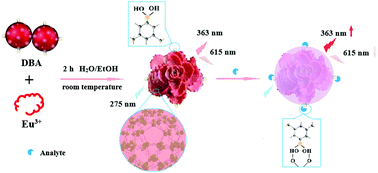One-step fabrication of a boric acid-functionalized lanthanide metal–organic framework as a ratiometric fluorescence sensor for the selective recognition of dopamine†
Abstract
In this work, a boric acid-modified lanthanide metal–organic framework (Eu-MOF) formed via a one-pot method was applied as a ratiometric fluorescence probe for the naked-eye recognition of dopamine (DA). The Eu-MOF probe combines the properties of boric acid with the ratiometric fluorescence technique, which is sensitive and selective. The Eu-MOF probe was prepared by a novel, rapid and simple approach at room temperature with 3,5-dicarboxybenzeneboronic acid (DBA) and Eu3+ ions. Due to the antenna effect, the Eu-MOF probe exhibited dual emission from both DBA and Eu3+ ion as a response signal under single excitation at 275 nm. Upon the addition of DA, boric acid covalently linked with the cis-diol compounds of DA. This caused the emission at 615 nm to gradually decrease, while the emission at 363 nm gradually increased, as could be observed by the naked eye from the color changes of the mixture. In addition, the Eu-MOF ratiometric fluorescence probe was used to detect DA in the concentration range of 0–500 μM under optimum measurement conditions with high selectivity and a low detection limit (0.015 μM). The Eu-MOF ratiometric fluorescence probe can also be used to detect other cis-diol substances, such as catechol and gallic acid. Moreover, the Eu-MOF probe was successfully used to detect DA in human serum samples. Therefore, the Eu-MOF probe proposed in this study provides a new method for the detection of DA and other similar substances.



 Please wait while we load your content...
Please wait while we load your content...